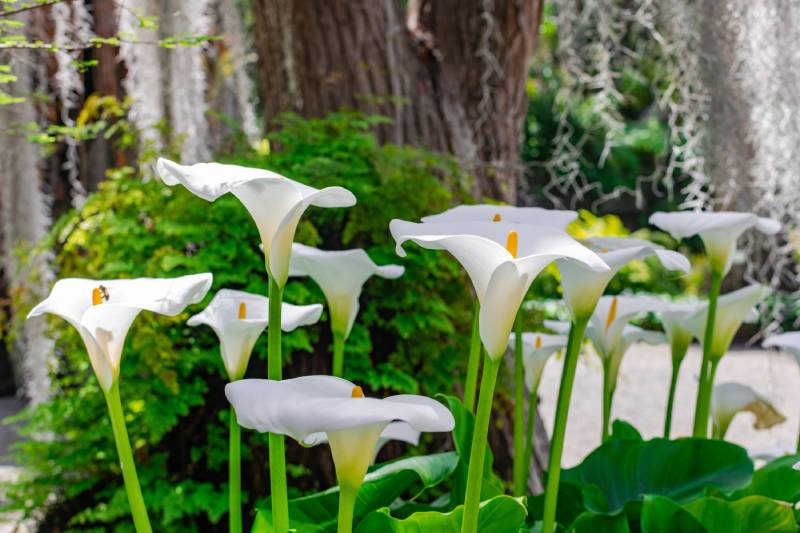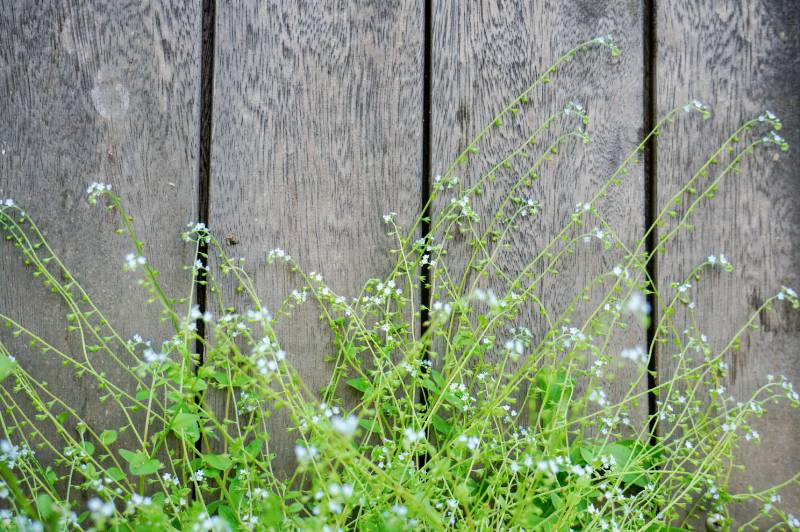Caring For Calla Lilies in the Garden

Calla Lilies are beautiful flowers that add sophistication and beauty to any garden. They are renowned for their stunning trumpet-shaped blooms. Caring for Calla Lilies can be a rewarding experience, offering stunning visual appeal and a profound sense of accomplishment. Whether you’re a seasoned gardener or a novice, this guide will provide you with all the essential information to plant, nurture, and maintain these magnificent plants. Let’s embark on a journey to create a thriving garden adorned with the captivating charm of Calla Lilies, and feel the pride of your gardening efforts.
What are Calla Lilies

Calla Lilies, scientifically known as Zantedeschia, are perennial plants native to South Africa. Celebrated for their distinctive flower structure, featuring a spathe (a large, petal-like bract) surrounding a central spadix (a spike of tiny flowers), these lilies come in various colors, including white, pink, yellow, and even deep purple. This versatility makes them a perfect choice for any garden design. Apart from their aesthetic appeal, Calla Lilies are also known for their symbolic meanings, representing purity, beauty, and rebirth. They thrive in well-drained soil and can adapt to both full sun and partial shade, giving you the power to design your garden as you please.
5 Best Ways to Plant Calla Lilies in Your Garden

- Choosing the Right Location
Choosing the perfect spot for your Calla Lilies is a crucial step for their successful growth. These plants prefer a location that receives plenty of sunlight, ideally around 6 hours a day. They can, however, also withstand some shade, particularly in warmer climates. Ensure the soil in the selected region drains properly to avoid waterlogging, which can cause root rot. Composted matter or organic matter can help with drainage and soil condition.
- Preparing the Soil
Before planting Calla Lilies, the soil must be meticulously prepared. To start, clear the area of any rocks or other debris and till the ground is about 12 inches loose. To enhance soil fertility and drainage, incorporate organic compost or well-rotted manure. Calla Lilies prefer soil between 6.0 and 6.5 pH, which is somewhat acidic instead of neutral. Create the ideal growing conditions for your lilies by checking and modifying the pH of the soil, if needed.
- Planting the Rhizomes
Calla Lilies originate from thick, meaty underground stems known as rhizomes. Plant the rhizomes with their eyes (growing tips) facing upward in the prepared soil, spacing them 12 to 18 inches apart. Three to four inches should be the planting depth. To help the rhizomes settle, completely cover them with dirt and water. To prevent hurting the vulnerable eyes during this procedure, use gentleness.
- Watering
Watering plants properly is essential during the first planting phase. Ensure the soil is uniformly moist but not soggy by giving the newly planted rhizomes plenty of water. Calla Lilies require consistent moisture, especially during the growing season. However, be cautious not to overwater, as this can cause root rot. Once established, water the plants regularly, aiming to keep the soil consistently moist but allowing the top inch to dry out between waterings.
- Mulching
By spreading a layer of mulch around your calla lilies, you can keep the soil moist, regulate temperature, and deter weed growth. Straw, wood chips, or shredded leaves are good examples of organic mulches. Cover the plants with a 2 to 3-inch layer of mulch to stop the rot, ensuring the mulch stays away from the stems. Mulching gives your garden beds a tidy appearance as well.
5 Seasonal Factors to be Kept in Mind When Including Calla Lilies in Your Garden

- Spring Planting
Calla Lilies can establish themselves before the intense summer heat by planting in the spring. Before planting, ensure the soil temperature is continuously higher than 60°F (15°C). The rhizomes have ideal circumstances during this time to sprout and increase.
- Summer Care
Calla Lilies will be in full bloom during the summer, showcasing their vibrant colors. Maintain regular watering to moisten the soil, and consider providing some afternoon shade in extremely hot climates. Deadhead wasted flowers to promote ongoing flowering and stop the plant from devoting its energy to seed production.
- Fall Preparation
Reduce watering gradually as autumn approaches so that plants can go into dormancy. Dig up the rhizomes before the first frost in colder areas where frost is dangerous, and store them in a cool, dry place. You can leave them in the ground in more excellent areas, protected by a thick layer of mulch.
- Winter Dormancy
Calla Lilies go dormant during winter, conserving energy for the next growing season. If you’ve stored the rhizomes, check them periodically for signs of rot or dehydration. Ensure the mulch layer remains intact in the garden to protect the rhizomes from freezing temperatures.
- Climate Adaptation
Calla Lilies are adaptable but thrive best in USDA hardiness zones 8-10. In colder zones, they need extra Care during winter to survive. Understanding your local climate and making necessary adjustments can help your Calla Lilies flourish year after year.
15 Best Ways to Take Care of the Calla Lily Plants in Your Garden

- Watering Consistently
Keep the soil’s moisture content constant to keep it uniformly damp but not soggy. This is particularly crucial when the plants are growing.
- Fertilizing
Throughout the growing season, feed your calla lilies with a balanced, water-soluble fertilizer every four to six weeks to encourage strong growth and colorful blooms.
- Pruning
Remove spent flowers and dead or yellowing foliage regularly to keep the plant healthy and encourage new growth.
- Pest Control
Monitor for common pests like aphids, spider mites, and snails. Use organic insecticides or natural predators to manage infestations.
- Disease Management
Prevent fungal diseases by avoiding overhead watering and ensuring good air circulation around the plants. Remove any infected foliage promptly.
- Mulching
As previously discussed, apply mulch to retain soil moisture, regulate temperature, and suppress weeds.
- Supporting Stems
Taller Calla Lily types should have support to keep them from tumbling over, especially in windy circumstances.
- Soil Testing
Regularly test soil pH and fertility to ensure optimal growing conditions and make necessary adjustments.
- Dividing Rhizomes
Divide overcrowded rhizomes every 3-4 years to maintain plant health and vigor. This also gives you more plants to expand your garden.
- Weed Control
Keep the area around your Calla Lilies free of weeds to reduce competition for nutrients and water.
- Winter Protection
In colder climates, dig up and store rhizomes during winter or provide ample mulch protection if left in the ground.
- Companion Planting
Plant Calla Lilies with other moisture-loving plants like hostas and ferns to create a harmonious garden ecosystem.
- Monitoring Sun Exposure
Adjust the location or provide shading if your Calla Lilies are exposed to excessive direct sunlight, which can scorch the leaves.
- Soil Amendments
Add organic matter to the soil annually to maintain fertility and improve structure.
- Enjoying the Blooms
Take time to appreciate the beauty of your Calla Lilies, as enjoying your garden is just as important as maintaining it.
Taking Care of the Plant at its Different Growth Stages

- Sprouting Stage
During the initial sprouting Stage, ensure the soil remains moist and provide gentle warmth to encourage growth. Avoid overwatering to prevent rot.
- Growing Stage
As the plants grow, maintain consistent moisture levels and provide balanced fertilization to support vigorous development. Keep an eye out for pests and diseases.
- Blooming Stage
During the blooming Stage, deadhead spent flowers encouraging continuous blooming and removing yellowing leaves to keep the plant healthy.
- Dormant Stage
In the dormant Stage, reduce watering and prepare the plants for winter dormancy by either digging up the rhizomes for storage or providing mulch protection.
Taking Care of Different Varieties of Calla Lilies

- White Calla Lilies
The most prevalent type of calla lily is Zantedeschia aethiopica, which is white. Compared to other kinds, it can withstand greater shade and prefers moist, well-drained soil.
- Colored Calla Lilies
Colored Calla Lilies, such as pink, yellow, and purple varieties, require full sun to partial shade and well-drained soil. They are slightly more sensitive to cold and may need extra winter protection.
- Dwarf Calla Lilies
Small garden areas and containers work well with dwarf types. Their care needs are comparable to those of other calla lilies; however, because of their smaller root systems, they could require more frequent watering.
- Giant Calla Lilies
Giant Calla Lilies can reach impressive heights and require ample space and support. They thrive in full sun and require rich, well-drained soil.
- Hybrid Calla Lilies
Hybrid Calla Lilies come in various colors and sizes, combining traits from different species. They require specific Care based on their parentage, so research your specific hybrid for best results.
Conclusion
Taking good Care of your calla lilies may make gardening enjoyable and rewarding. If you understand their demands and give them the proper Care, you can enjoy their breathtaking beauty throughout the growth season. Every Stage, from choosing the ideal spot and preparing the soil to control pests and illnesses, adds to your calla lilies’ general well-being and vigor. With these tips and insights, creating a garden that embodies the elegance and charm of calla lilies won’t be difficult.


Leave a Reply